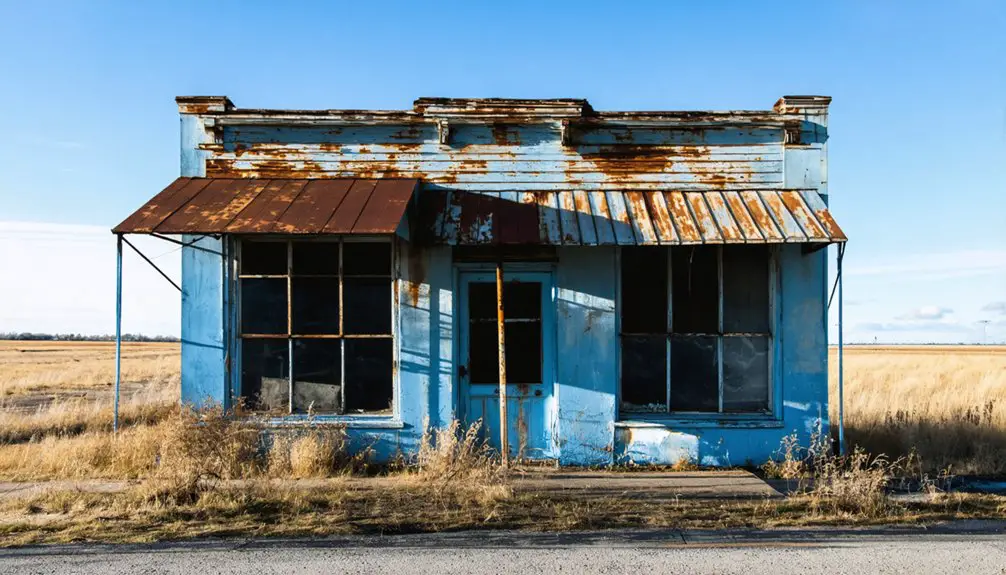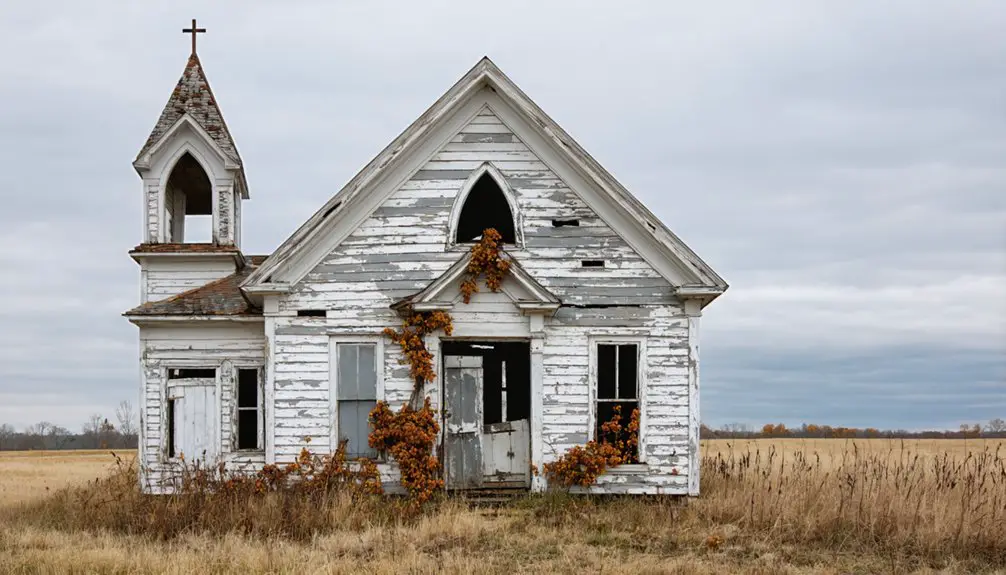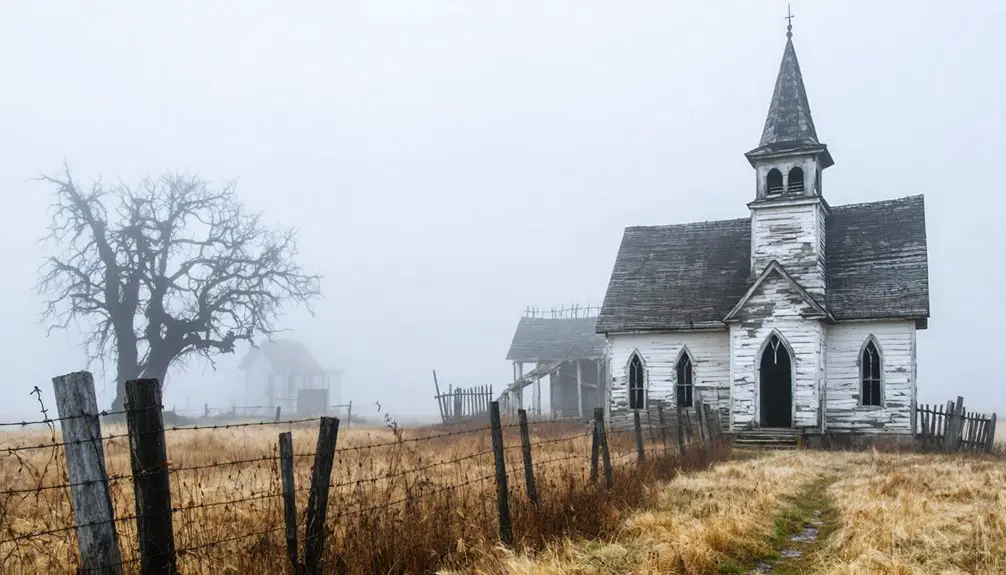You’ll find Goldman’s remnants along Old Lemay Ferry Road in Jefferson County, Missouri, where it evolved from Sandy Mines (1844) to a merchant-driven community. The Goldman brothers’ general store and post office once anchored this settlement, while the historic Sandy Creek Covered Bridge (1872) still spans its namesake creek. Though the town declined after 1905, you can explore the preserved covered bridge, scattered foundations, and quiet Ozark foothill landscapes that whisper tales of this forgotten community.
Key Takeaways
- Goldman transformed from Sandy Mines to a merchant hub after the Goldman brothers established their store along Old Lemay Ferry Road.
- The town’s decline began after its post office closed in 1905, leading to population loss and economic challenges.
- The Sandy Creek Covered Bridge, built in 1872, remains as the most prominent historical landmark of the former community.
- Only the fire district continues to operate in Goldman, while most historic buildings have deteriorated or disappeared.
- Located in Jefferson County’s Ozark foothills, Goldman’s landscape now features abandoned foundations, disused roads, and wildlife-rich forests.
From Sandy Mines to Goldman: A Name’s Evolution
While mining activity shaped the early identity of this Missouri settlement, the evolution of its name from Sandy Mines to Goldman reflects the community’s changing economic focus.
You’ll find the earliest records from 1844 referring to the area as Sandy Mines, with locals later using Sandy Bridge by 1882 due to the nearby covered bridge.
The community identity shifted when two Goldman brothers opened a store, prompting the town’s renaming. This name significance coincided with the relocation of the central log building and store from a creek-side location to higher ground. When Sam Goldman of St. Louis acquired the business, his prominent store sign solidified the Goldman name in the community. A devastating flood destroyed the original bridge, leading to its reconstruction in the 1880s.
The Goldman brothers’ general store catalyzed both the town’s new name and its shift from creekside mining camp to hilltop trading post.
The change marked more than just a change in name – it represented the area’s evolution from a mining-focused settlement to a merchant-driven community, though the post office eventually discontinued operations.
Life Along Old Lemay Ferry Road
Old Lemay Ferry Road shaped the destiny of Goldman and surrounding Jefferson County as an essential artery between Hillsboro and St. Louis.
You’d find the heart of community life centered around a log building that served as both store and post office, where local traditions and community gatherings flourished in the late 1800s. Early French Jesuits who established a mission in 1700 near the area marked the beginning of European settlement in the region.
The Goldman brothers’ businesses and prominent families like the Hensleys and Marsdens established the area’s economic foundation. Like many successful merchant families of the era, the Goldmans represented the legacy of Jewish surname origins that helped shape American commerce.
Germanic immigrants contributed to the region’s cultural fabric, while the construction of six covered bridges in 1872, including the iconic Sandy Creek Bridge, transformed transportation.
When you traveled this route, you’d encounter traders, merchants, and families who relied on this crucial thoroughfare for commerce and social connection throughout Jefferson County.
The Goldman Brothers’ Legacy
When two entrepreneurial brothers established a general store along Old Lemay Ferry Road in the late 19th century, they couldn’t have known their name would become permanently linked to this corner of Jefferson County. Their entrepreneurial spirit shaped the community’s identity, with the Goldman heritage extending beyond mere retail operations.
Sam Goldman’s prominent store signage and Louis Goldman’s role as the first postmaster in 1895 cemented the family’s influence in the area.
The Goldman brothers left their mark on the community through their pioneering retail presence and Louis’s historic role as postmaster.
You’ll find traces of their legacy in the broader Goldman family success story across Missouri, including connections to the Goldman Jewelry Company in Kansas City, which became nationally recognized for its Art Deco designs. The company’s reputation for excellence continued to grow until it became a many-million dollar business after relocating to Walnut Street in 1927. The family’s expertise in jewelry retail continued through generations, with descendants like John Goldman working at Medco Jewelry Corp.
Though the post office closed in 1905, the Goldman name endures as a symbol of early commerce in rural Missouri.
Sandy Creek Covered Bridge: A Standing Monument
Standing proudly since 1872, the Sandy Creek Covered Bridge represents a remarkable piece of Missouri’s post-Civil War infrastructure. You’ll find this historic gem along Old Lemay Ferry Road, where it once served as a crucial link between Hillsboro and St. Louis County. The bridge was originally constructed by John H. Morse for $2000.
The bridge’s covered bridge history includes destruction by flooding in 1886 and rebuilding in 1887, using half of the original timbers. Today, visitors can enjoy picnic facilities while taking in the scenic surroundings.
The engineering significance of this 74.5-foot structure lies in its Howe truss design, featuring innovative vertical rods that tension wooden members for strength.
As one of only four remaining covered bridges in Missouri, it’s now preserved as a state historic site. You can walk through this red barnlike structure year-round, experiencing a rare surviving example of 19th-century American engineering ingenuity.
Early Commerce and Trading Routes
Along the historic path that would become Old Lemay Ferry Road, Goldman emerged as a significant trading post connecting Hillsboro and St. Louis. Much like the Santa Fe Trail established vital commerce between Missouri and New Mexico territories, Goldman played a key regional role.
You’ll find that early trading practices centered around the Goldman brothers’ general store, which served as an essential hub for local commerce. Similar to how the Mandan trade center near Bismarck thrived on agricultural commerce, the town’s regional market influence extended throughout Jefferson County, facilitating the exchange of agricultural goods and important supplies between St. Louis’s urban markets.
- The Goldman brothers established their mercantile presence, lending their name to the settlement
- A post office operated from 1895 to 1905, marking Goldman’s peak trading period
- Local merchants traded agricultural products from nearby farms for manufactured goods
- Indigenous trade routes influenced the development of later commercial pathways
- The town’s location along Old Lemay Ferry Road guaranteed steady traffic of traders and travelers
Post Office Era: 1895-1905
The establishment of Goldman’s post office in 1895 marked a new chapter in the town’s commercial development, building upon its trading post legacy.
Goldman’s 1895 post office opening signaled its evolution from frontier trading post to an established commercial center.
You’ll find detailed records of its post office functions in the Post Office Department’s Record Group 28, which documented everything from postmaster appointments to site locations in Jefferson County.
For a decade, Goldman’s post office served as a crucial hub of community connectivity, with postmasters managing mail delivery, receipts, and dispatches.
They’d submit detailed reports that helped shape postal routes and influenced the Post Office Topographer’s maps.
By 1905, Goldman’s postal services came to an end during a broader shift to rural free delivery (RFD).
The closure reflected changing times as the postal service consolidated operations and expanded rural routes throughout Missouri.
Lily Marsden’s Historical Accounts
You’ll find Lily Marsden’s memories of early Goldman particularly valuable, as she witnessed the area’s evolution from Sandy to Goldman while her mother operated the local store and post office.
Her accounts detail how her mother purchased and relocated a log building to what would become Goldman’s central location, establishing one of the settlement’s first commercial enterprises.
Through Marsden’s recollections, preserved in the 1949 *News Democrat*, you can trace the development of this Missouri settlement, including the construction of the covered bridge in 1872 that connected Jefferson County to St. Louis.
Early Settlement Memories
Through her detailed recollections as one of Goldman’s earliest residents, Lily Marsden (née Hensley) provided invaluable insights into the settlement’s shift from Sandy to Goldman in the late 1800s. Her memories paint a vivid picture of pioneer family dynamics, with her mother running the local store and post office near Sandy Creek.
Early community gatherings often centered around the store, which later relocated to the hill that would become Goldman’s heart.
- Her parents, Alexander and Virginia Moss Hensley, were integral to the area’s development.
- The family store served as a crucial hub for local commerce and social interaction.
- Log dwellings near the original store marked the earliest settlement pattern.
- The covered wooden bridge, built around 1872, connected the community to Hillsboro and St. Louis.
- Daily life revolved around farming, trading, and maintaining strong community bonds.
Family Store Relocation Tales
Among Goldman’s most significant commercial developments, Lily Marsden’s family store underwent a crucial relocation that shaped the town’s eventual identity.
You’ll find the store’s significance traced back to when the area was known as Sandy, where Marsden’s mother operated both the store and post office from a log building.
When the community shifted to Goldman, the family seized the opportunity to establish a new community hub by moving their enterprise to a strategic hilltop location.
The store’s role as an essential connection point for residents expanded during this shift, with Lily Marsden, who’d later become known as “Goldman’s oldest citizen,” witnessing the transformation firsthand.
The relocation marked a turning point, helping consolidate Goldman’s commercial center and strengthening local trade networks.
Transportation’s Role in Community Development
Transportation infrastructure played a pivotal role in Goldman’s early development, with the 1872 Sandy Covered Bridge and Lemay Ferry gravel road serving as critical arteries for commerce and connectivity.
The construction of Sandy Covered Bridge and Lemay Ferry road in 1872 transformed Goldman from isolation to vital commercial crossroads.
These transportation networks transformed Goldman from an isolated settlement into a connected rural community, enabling the movement of goods and people throughout Jefferson County.
- Sandy Covered Bridge enhanced local mobility and trade across Sandy Creek
- Lemay Ferry road linked Goldman to both Hillsboro and St. Louis markets
- Multiple covered bridges built in 1872 reflected countywide infrastructure investment
- Rural connectivity supported the Goldman brothers’ store operations and post office
- Nearby railroad development in towns like Hematite influenced regional trade patterns
You’ll find that Goldman’s growth was intrinsically tied to these transportation corridors, which shaped settlement patterns and determined the community’s economic viability throughout its early years.
Decline of a Rural Settlement
While Goldman initially flourished as a rural commerce hub centered around the Goldman brothers’ store, the settlement’s decline began in the early 20th century with the closure of its post office.
You’ll find that this closure triggered a cascade of economic challenges that severely tested the community’s resilience. As younger residents left for urban opportunities, the town’s economic sustainability weakened, leading to the closure of businesses and essential services.
The once-vibrant social fabric, anchored by families like the Hensleys, gradually unraveled as population numbers dwindled. By mid-century, Goldman’s physical landscape reflected this decline – historic buildings deteriorated, the old covered bridge became purely decorative, and surrounding lands fell into disuse.
Only the fire district remains as a reminder of Goldman’s once-active community life.
Historic Landmarks and Modern Remnants
If you’re exploring Goldman’s remaining historical features today, you’ll find the Sandy Creek Covered Bridge stands as the town’s sole preserved landmark from 1872, marking an essential transportation link between Hillsboro and St. Louis.
While the Goldman Trading Post’s original log structure was relocated to a nearby hill before eventually disappearing, no visible traces of this early commercial hub remain.
The rural countryside that once supported a bustling mining settlement now hosts only the fire district facilities, with the covered bridge drawing visitors interested in Missouri’s transportation heritage.
Sandy Creek Covered Bridge
A remarkable piece of Missouri’s architectural heritage, the Sandy Creek Covered Bridge stands as one of four surviving covered bridges in the state. Built in 1872 by John H. Morse for $2,000, this Howe truss design bridge continues to draw visitors to Goldman.
After destruction by flooding in 1886, Henry Steffin rebuilt it in 1887 using half of the original timbers. Today, the bridge’s preservation and cultural significance are protected through its status as a Missouri state historic site and listing on the National Register of Historic Places.
- Red barn-like exterior spans 76 feet across Sandy Creek, standing 13 feet high
- Accessible via Route 21 and Goldman Road, with convenient parking for visitors
- Features picnic facilities, restrooms, and interpretive displays about covered bridges
- Creek area offers opportunities for wildlife viewing and fossil hunting
- Popular year-round destination for photographers capturing seasonal changes
Goldman Trading Post Ruins
Beyond the Sandy Creek Covered Bridge lies another indication of Goldman’s rich history – the remnants of the Goldman Trading Post. Dating to the mid-19th century, you’ll find the ruins of this once-bustling hub that connected Native American tribes with European settlers along essential trading routes.
The post’s strategic location in the Missouri River valley made it significant for the region’s fur trade and cultural exchange.
The site’s remaining log and timber structures reveal the craftsmanship of frontier architecture, with hand-hewn logs and stone foundations telling stories of commerce and survival.
You can still spot evidence of the main trading house and storage rooms where cloth, metal tools, pelts, and hides once changed hands.
These ruins stand as a reflection of Missouri’s complex frontier dynamics and the intersection of French, American, and indigenous cultures.
Rural Countryside Setting
Today’s rural countryside surrounding Goldman reveals the layered history of Jefferson County’s Ozark foothills.
You’ll find rolling hills dotted with patches of dense forest and sparse farmland, where rural wildlife thrives in the quiet atmosphere. The landscape preservation efforts have maintained the natural beauty of small creeks and tributaries that weave through the terrain, shaping the path of Old Lemay Ferry Road.
- Former post office site and covered bridge stand as evidence to 19th-century infrastructure
- Original “Goldman” signage remains visible, marking the town’s historical presence
- Fire district operations continue as one of few organized services
- Disused road segments hint at previous commercial activity
- Building foundations scatter the area, revealing past settlement patterns
Frequently Asked Questions
What Happened to the Original Goldman Brothers After Leaving the Area?
Like stars aligning in destiny’s sky, you’ll find the Goldman legacy shifted to Kansas City, where the brothers’ ventures blossomed into Goldman Jewelry Co., shaping America’s jewelry industry through Jewelry, Inc.
How Many People Currently Live Within Goldman’s Original Boundaries?
You won’t find anyone living within the historical boundaries today – population statistics indicate zero permanent residents in what’s now considered abandoned territory where the original town once stood.
Were There Any Notable Crimes or Incidents During Goldman’s Peak Years?
You’ll find few notorious incidents in the historical records, with only minor disturbances documented – like Quinly’s window-smashing and Roach’s self-harm attempt. No significant crime statistics emerge from Goldman’s peak years.
What Natural Disasters or Severe Weather Events Impacted Goldman Historically?
While you’d expect devastating tales, historical records don’t show major disasters hitting Goldman directly. Sandy Creek brought some flood impacts, and Jefferson County’s tornado history suggests possible storm damage.
Did Goldman Ever Have a School or Church During Its Existence?
You won’t find any documented evidence of a formal school or church in the historical records – nearby communities likely provided these services for Goldman’s small merchant-focused population.
References
- https://www.myleaderpaper.com/features/looking_back/looking-back—-to-the-town-of-goldman/article_7571e8c2-1770-11e4-929c-001a4bcf6878.html
- https://en.wikipedia.org/wiki/Goldman
- https://www.youtube.com/watch?v=3ElM_xAtbAY
- https://www.youtube.com/playlist?list=PL4jqwLUrhjNScUWj03mXzSKyBNMNqZHGw
- https://www.youtube.com/watch?v=Nrh1eUwOwrM
- https://historic-jeffco.com/data/Document.pdf
- https://pubs.usgs.gov/sir/2016/5173/sir20165173.pdf
- https://shsmo.org/collections/manuscripts/ramsay/jefferson
- https://www.afftonlemaychamber.com/history-of-lemay.html
- https://www.visitmo.com/things-to-do/sandy-creek-covered-bridge-state-historic-site



